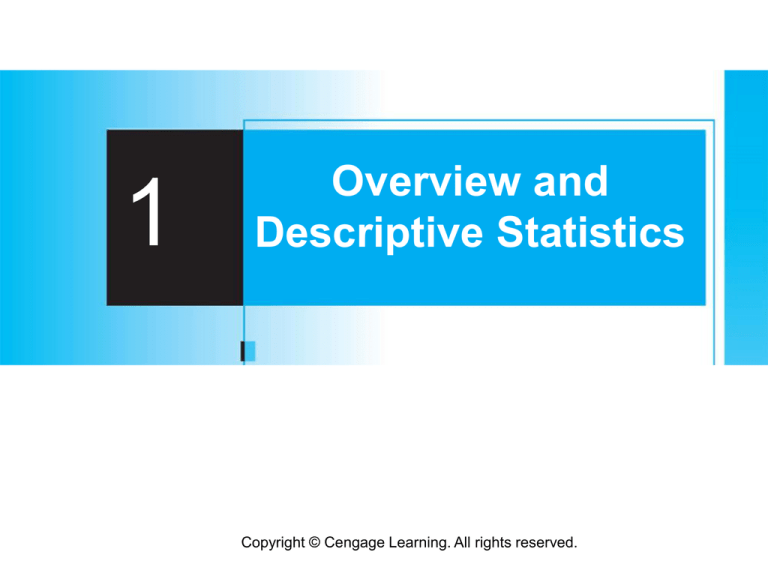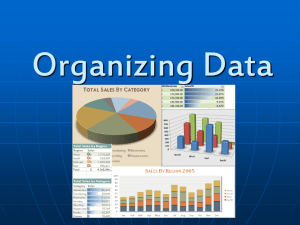
1
Overview and
Descriptive Statistics
Copyright © Cengage Learning. All rights reserved.
Populations, Samples and Variables
Collections of facts, or data
Population: all objects that are interested for a particular
project. Eg. census.
Sample: a subset of population
Variable: a particular characteristic, measured
2
1.2
Pictorial and Tabular Methods
in Descriptive Statistics
Copyright © Cengage Learning. All rights reserved.
Pictorial and Tabular Methods in Descriptive Statistics
Two subject areas of descriptive statistics:
visual vs numerical.
Examples of familiar visual techniques:
frequency tables,
tally sheets,
histograms,
pie charts,
bar graphs,
scatter diagrams
4
Notation
sample size: the number of observations in a sample, n
eg, n = 4, for the sample of universities {Stanford, Iowa
State, Wyoming, Rochester}
and also for the sample of pH measurements
{ 6.3, 6.2, 5.9, 6.5}.
Given a data set of n observations on a variable x, the
individual observations will be denoted by x1, x2, x3,…, xn.
Usually, x1 will be the first observation gathered, x2 the
second, and so on. The ith observation in the data set will
be denoted by xi.
5
Dotplots
Each observation is one dot above a horizontal scale.
When more than once observations have the same value,
the dots are stacked vertically.
Good for small data set
data set with a few distinct values
A dotplot gives information about location, spread,
extremes, and gaps.
6
Example
Higher education as a % of state and local tax revenue for
the fiscal year 2006–2007 for all states (AL first, WY last):
10.8 6.9 8.0 8.8 7.3 3.6 4.1 6.0 4.4 8.3
8.1 8.0 5.9 5.9 7.6 8.9 8.5 8.1 4.2 5.7
4.0 6.7 5.8 9.9 5.6 5.8 9.3 6.2 2.5 4.5
12.8 3.5 10.0 9.1 5.0 8.1 5.3 3.9 4.0 8.0
7.4 7.5 8.4 8.3 2.6 5.1 6.0 7.0 6.5 10.3
NM
VM
NH
7
Histograms
Discrete variable: finite or countable possible. Often
obtained by counting to determine the value of a variable,
say the # of trucks passing through a checkpoint in a hour.
Continuous variable: possible values consist of an entire
interval on the number line. Often obtained by taking
measurements.
Histograms for discrete and continuous variables are
constructed slightly different.
8
Histogram Concepts for Discrete Variable
The frequency of an x value is the number of times that
value occurs in the data set.
The relative frequency of a value is the fraction or
proportion of times the value occurs:
Example: a data set with 200 observations on x = the
number of courses a college student is taking this term. If
70 of these x values are 3, then
frequency of the x value 3: 70
relative frequency of the x value 3: 70/200=0.35 or 35%
The relative frequencies of all values should sum to 1
(allowing rounding errors)
9
Histograms for Discrete Data
10
Example 9
cont’d
Table 1.1 is a frequency distribution for the number of hits
per baseball team per game for all nine-inning games that
were played between 1989 and 1993.
Frequency Distribution for Hits in Nine-Inning Games
Table 1.1
11
Example 9
cont’d
The corresponding histogram in Figure 1.7 rises rather
smoothly to a single peak and then declines. The histogram
extends a bit more on the right (toward large values) than it
does on the left—a slight “positive skew.”
Histogram of number of hits per nine-inning game
Figure 1.7
12
Example 9
cont’d
Either from the tabulated information or from the histogram
itself, we can determine the following:
= .0010 +.0037 + .0108
= .0155
Similarly,
= .6361
That is, roughly 64% of all these games resulted in
between 5 and 10 (inclusive) hits.
13
Histogram for Continuous varaibles
14
Histograms
Constructing a histogram for continuous data
(measurements) entails subdividing the measurement axis
into a suitable number of class intervals or classes, such
that each observation is contained in exactly one class.
Suppose, for example, that we have 50 observations on
x = fuel efficiency of an automobile (mpg), the smallest of
which is 27.8 and the largest of which is 31.4. Then we
could use the class boundaries 27.5, 28.0, 28.5, . . . , and
31.5 as shown here:
15
Histograms: Dealing with boundaries
One potential difficulty is that occasionally an observation
lies on a class boundary so therefore does not fall in
exactly one interval, for example, 29.0.
One way to deal with this problem is to use boundaries like
27.55, 28.05, . . . , 31.55. Adding a hundredths digit to the
class boundaries prevents observations from falling on the
resulting boundaries.
Another approach is to place an observation on a boundary
in the interval to the right of the boundary. This is how
Minitab constructs a histogram.
16
Histogram Shapes
A Unimodal histogram: single peak
A bimodal histogram: two different peaks
Bimodality can occur when the data set consists of
observations on two quite different kinds of objects. Eg. a data
set of driving times between San Luis Obispo, and Monterey,
CA, two routes: inland (≈ 2.5 hr) and coast (3.5–4 hr). However,
A data set of college student heights may NOT result in a
bimodal histogram, male around 69”, female around 64”.
A multimodal histogram: multiple peaks
The number of peaks may depend on the choice of class
intervals, particularly with a small number of observations.
The more classes, the more peaks will manifest itself.
17
Example 12
Figure 1.11(a) shows a Minitab histogram of the weights
(lb) of the 124 players listed on the rosters of the San
Francisco 49ers and the New England Patriots (teams the
author would like to see meet in the Super Bowl) as of Nov.
20, 2009.
Others
Linebacker
Linemen
NFL player weights Histogram
Figure 1.11(a)
18
Histogram Shapes: symmetric or skewed
A histogram is symmetric if the left half is a mirror image
of the right half. A unimodal histogram is positively
skewed if the right or upper tail is stretched out compared
with the left or lower tail and negatively skewed if the
stretching is to the left.
19
Example 12
cont’d
Figure 1.12 shows “smoothed” histograms, obtained by
superimposing a smooth curve on the rectangles, that
illustrate the various possibilities.
(a) symmetric unimodal
(c) Positively skewed
(b) bimodal
(d) negatively skewed
(e) NFL player weights Smoothed histogram
Smoothed histograms
Figure 1.12
20
Qualitative Data
Both a frequency distribution and a histogram can be
constructed when the data set is qualitative (categorical) in
nature.
Ordered: eg, freshmen, sophomores, juniors, seniors,
graduate students
Non-ordered: eg, Catholic, Jewish, Protestant, Muslim and
the like.
The intervals should have equal width.
21
Example 13
cont’d
How do you rate your school?
Frequency Distribution for the School Rating Data
Table 1.2
Histogram of the school rating data from Minitab
Figure 1.13
More than half the respondents gave an A or B rating, and only slightly
more than 10% gave a D or F rating.
22
Multivariate Data
Multivariate data is generally rather difficult to describe
visually. Several methods for doing so appear later in the
book, notably scatter plots for bivariate numerical data.
23








